Salon du Tapis d'Orient
The Salon du Tapis d'Orient is a moderated discussion group in the manner of the 19th century salon devoted
to oriental rugs and textiles and all aspects of their appreciation. Please include your full name and e-mail address
in your posting.
What I Learned at ACOR....
by Jerry Silverman
As some of you may recall, a while back I made the modest proposal that there shouldn't be any more rug conferences
until AD 2002. There was too little scholarship spread over too many lectures. Too much redundancy at too high
a cost. Too much preening and posing and too little accomplishment. Why not take a few years off to let theories
mature and to allow field research to gather evidence to support the theories?
This modest proposal received an immodest response, ranging from embarrassed support to angry dismissal. I found
the most convincing argument for the continuation of rug conferences to be the opportunity they present for the
camaraderie and bonhommie of being together with so many like minded people.
And that's what ACOR has done from the very beginning, better than any other. From March 30 to April 2, 2000 in
Burlingame, California, they did it again.
The trick seems to be jamming as much of the conference as possible into a single venue. Like the primordial ooze
from which life evolved, compressing the guest rooms, meeting rooms, dining rooms, administrative areas, exhibition
space, and dealer fair into the Embassy Suites almost assures the evolution of a unique rug appreciation experience.
Even excursions from the hotel had a cocooned feeling to them as chartered buses whisked people to the private
events and back. The same 375 people met and re-met in endlessly changing combinations and permutations for presentations,
meals, in dealer's rooms, at exhibitions, in elevators, on buses. Friendships are made; antagonisms confirmed;
opinions re-examined.
Still, one cannot take it all in. The major limitation is that three presentations are being made at the same time.
They aren't repeated; so you must choose which to see and which to miss. It is my only major complaint about ACOR.
Extending it by one day so each session could be repeated would be worth another day's hotel bill - at least for
me.
What follows are impressions of ACOR 5. I encourage others who were there to augment my recollections with their
own. As I said, a single person can't experience it all.
Dealer's Row opened with a reception on Thursday evening. (Note: The key word in the preceding sentence is "reception.")
While the first trick to making ACORs successful is the "hothouse" single venue, the second trick is
to have abundant FREE food. Every evening there is a reception where the participant is certain to be able to have
a full
dinner. Combined with staying in a hotel that serves free breakfast, and supported with coffee and sweetroll service
between presentations, the only problem is over-eating. In an elevator on that first evening an ACOR volunteer
confided to me that, "The secret to ACOR's success is lots of food. When there's a lot of food, nothing else
is a problem.
When there isn't enough food, every little thing becomes a problem."
But I digress. The Dealer's Row occupied two floors and included some 67 dealers and auxiliary service providers
(a euphemism for magazines and Internet sites). My first impression was that there weren't many "Oh my gosh!"
pieces. I must admit, though, that this is always my impression of the dealers' offerings at every conference I've
ever
attended. I'm pretty sure that it's a manifestation of "taste inflation" that results from seeing so
many great rugs in the presentations and exhibitions. Your eye is making constant comparison between what you've
seen - often the best of its kind - and what's for
sale.




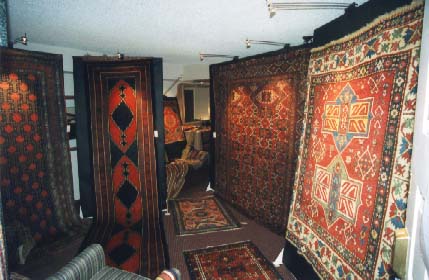
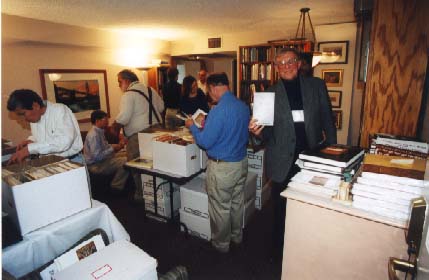
Rarely do the dealer inventories measure up. But now and then they do. One Turkish dealer in particular had
a pile of several dozen Kaitag embroideries. I've never seen so many at once before. Each handkerchief-thin piece
was more spectacular than the next. And while I admit to knowing very little about them, I was enormously struck
by the
spirituality each seemed to embody. All those words one hears bandied about to describe the best Kazaks seem much
more apt when referring to Kaitags: archaic, totemic, primitive, bold, dramatic. Add to those: numinous. If one
of their uses was to protect infants from the evil eye, I imagine they performed admirably. In the cost/weight
ratio they are the closest thing the textile world has to heroin.
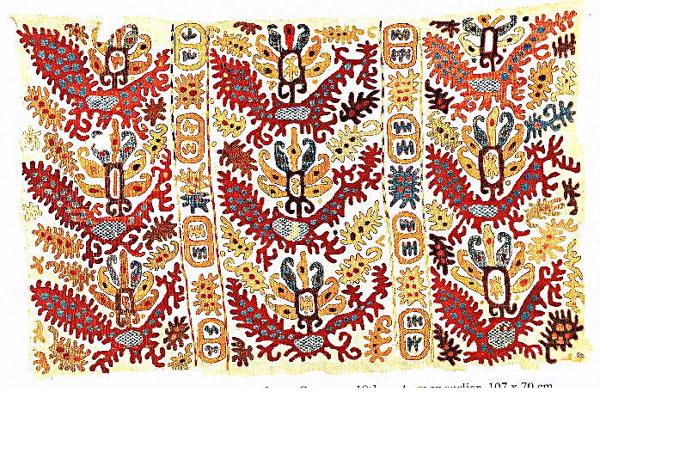
Rugs ringed the third and fourth floor railings of the Dealer's Row. Within hours rugs were also hanging
from railings on the fifth, seventh, eighth, and ninth floors. Rogue dealers who hadn't registered for Dealer's
Row had rented rooms and just shown up for the event. Some were very well known individuals in the rug world. There
was considerable displeasure at this by the dealers who paid the extra fee to register for the Dealer's Row and
by the ACOR volunteers who had to deal with the party crashers. Since they had legitimately reserved their rooms
they were obviously free to stay, but they were prevented from hanging their rugs over the railing. I'm not sure
if this made much difference as anyone who wanted to know where they were simply had to walk around the floors
and look in the windows.
While wandering about with a soda in one hand and a plate of indescribably succulent California fruit in the other,
I noticed a Kurdish rug in one of the dealer's rooms. Nice, I thought, but no matter; I never buy anything at rug
conferences.
The first day of the conference started out with a presentation by Heinrich Kirchheim on "The Art of Collecting."
As I listened to the noted collector, I was struck by how inexpensive/underpriced textile art is and that for the
price of a single, good Impressionist painting ($15 million) one could build a world-class oriental rug collection
(it takes good judgement, courage, ego, and charm, too, just not as much money as you might think). Herr Kirchheim
confessed that to get one rug he wanted, "A collector has to do terrible things. I had to eat testicles."
On another occasion "A dealer fed me with his own hands. His fingernails were horrible." He plans a book
on one hundred pre-16th century rugs that have all been carbon-dated.
In other presentations, Tom Cook drew from his extensive collection of South Persian textiles to show design
relationships between gabbehs, kilims, and jajims. In one of the more confusing presentations Vedat Karadag attempted
to tell how he distinguishes between Yoruk rugs and other south central Anatolian production. There was quite a
bit of nervous throat-clearing when he pointed to a design and said, "And here's the always popular swastika."
Josephine Powell's presentation brought something rarely experienced at a rug conference: someone who'd been in
the field, seen it firsthand, photographed and annotated it. For over 20 years this still vital octagenarian took
some 30,000 photographs of Anatolian weavers and their lives and weavings. Her photographs, field notes, books,
and a broad selection of textiles and ethnographic objects has been given to start the Center for Anatolian Ethnography
and Textile Studies in Istanbul.
A frequent contributor to TurkoTek, Wendel Swan spoke on copies, fakes and frauds, attempting to draw distinctions
between honest and conservative design traditions and reproductions created to deceive. If you'd like to comment
on this subject, how about addressing the question: Is a perfect copy of a great rug also a great rug?
Friday evening was the reception for "Passages II - Recent Acquisitions from Bay Area Collections." A
little of this and a little of that - some of which were wonderful. I have, for instance, seen hundreds of Turkish
yastiks which held not the least bit of interest for me. But there was a little (1'6" x 3') 19th century Konya(?)
yastik from the LePell collection that stopped me cold.
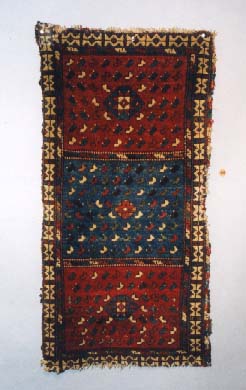
Tibetan textiles also usually make my eyes glaze over, but there were two pieces that I would have owned in an
instant. One was an 18th century (33" x 34") patchwork altar cloth made of Chinese silk, and the other
was an early Ming dynasty (1386 - 1644) brocade with roundel and writing. Both are in the Lyman collection.
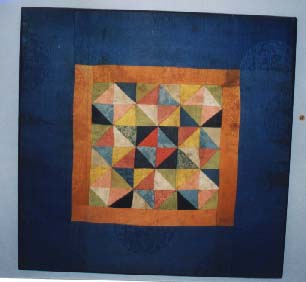
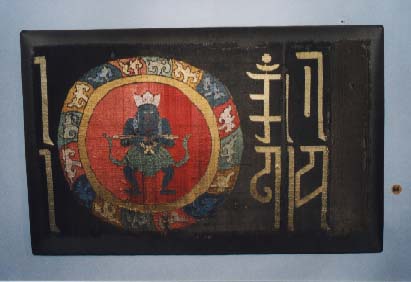
These pieces and the 68 others were well-guarded from our unrestrained acquisitive impulses. Not one was stolen.
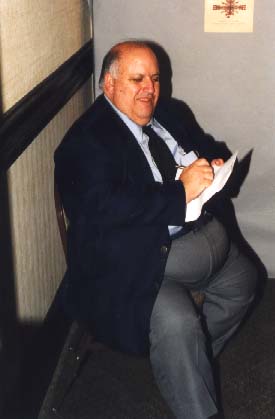
Saturday started for me with Murray Eiland Jr.'s discussion of the Turkmen rugs in the Wiedersperg Collection.
As the co-author along with Robert Pinner of the catalog of the collection he was very familiar with the pieces.
Interestingly, he seemed to be sceptical of the validity of C-14 dating for Turkmen pieces. And he noted a possible
relationship
between Turkomania and the Germanic nature - the desire for strict ordering seems to appeal to something in the
Germanic psyche.
Next was a tornado named Cathy Cootner who addressed "Aesthetics: The Warp and Weft of Beauty." How does
a collector decide which particular rug or flatweave is the best or most beautiful of its type? For her it is all
about color and wool that is "hungry for the dye." Pile rugs that are best of type are like "a rabbit
in your pants, pulling you every which way." Exhillarating! The Chicago Rug Society immediately signed her
up for a meeting in the fall.
Mike Tschebull talked about the influence of Caucasian flatweaves on pile rugs. Thoughtful, honest, and not over-reaching,
his presentation was illustrated by a great many examples. Mike isn't the tallest guy, and neither were his assistants
who were helping mount the pieces on the tall display easels. The trick was to attach the rug to a row of short
nails atop each easel to hold the piece in place. While stretching on tiptoes to mount a Shirvan kilim, trying
to get it to hang straight, there was a pulling, tearing sound. An audible gasp burst from the audience...then
a nervous laugh. We were truly united in that moment.
Saturday's last session for me was Mark Hopkin's patented "Good rug. Great rug." panel. I've participated
in three of these and seen four. They're always a great success as three "experts" offer their first
impressions of two slides of rugs, side by side, in 30 seconds. The one consistent truth I've taken away from these
is that rugs with white borders or white fields consistently rank higher than those without. Why this is is a complete
mystery to me.
That evening buses took everyone to the DeYoung Museum for the reception for the Wiedersperg exhibition. To be
honest, I was not alone in being sort of underwhelmed. Only a fraction of the pieces donated to the museum were
displayed, and few of those were what avid Turkomaniacs would consider to be "best of type." The Yomud
main rugs were probably the best of the bunch. Even the huge Salor trapping was disappointing.
A late dinner with Silicon Valley friends made me miss Sunday morning's first sessions. Perhaps Steve Price will
report on the panel he moderated, "Marketplace Trends in Collectible Rugs", which featured Mary Jo Otsea,
Peter Pap, and Dennis Marquand.
The final plenary session was a show-and-tell free-for-all: Mystery Rugs - a panel moderated by Wendel Swan consisting
of Anne Halley, Cathy Cootner, Denny Shaffer, and Mike Tschebull. Wendel brought a bunch of real head-scratchers
for the panel to examine. It reminded us all that when it comes to attribution there are still more questions than
answers.
The final event for those who signed-up for it was a visit to Jim Dixon's home in Occidental, California, - 2 1/2
hours by bus from the hotel. A box lunch was provided (see: ACOR Rule #1) as was a spectacularly warm, sunny day.
If Richard Halliburton were still alive, he'd have to include Jim's home as one of the Wonders of the Occident(al).

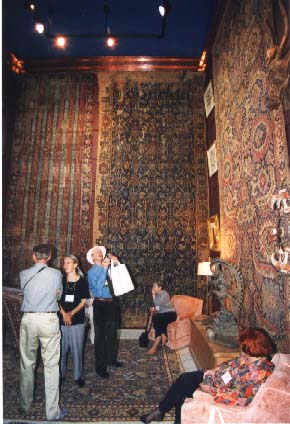
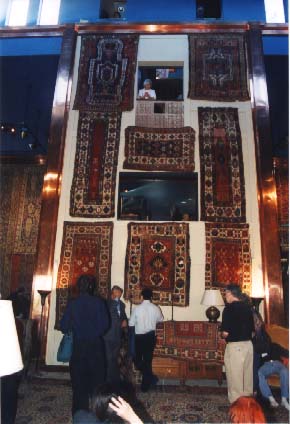
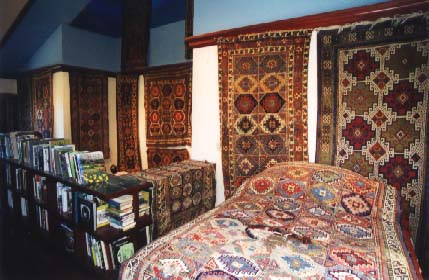
Better pictures are available in the HALI #109.
Sunday evening I had just enough energy left to revisit that Kurdish rug that caught my eye at the Dealer's Row
reception. In two decades of rug conference attendance I'd never bought anything other than books, but this rug
overcame my reticence. A quick 10-minute haggle concerning repairs and a final price ended in a handshake.
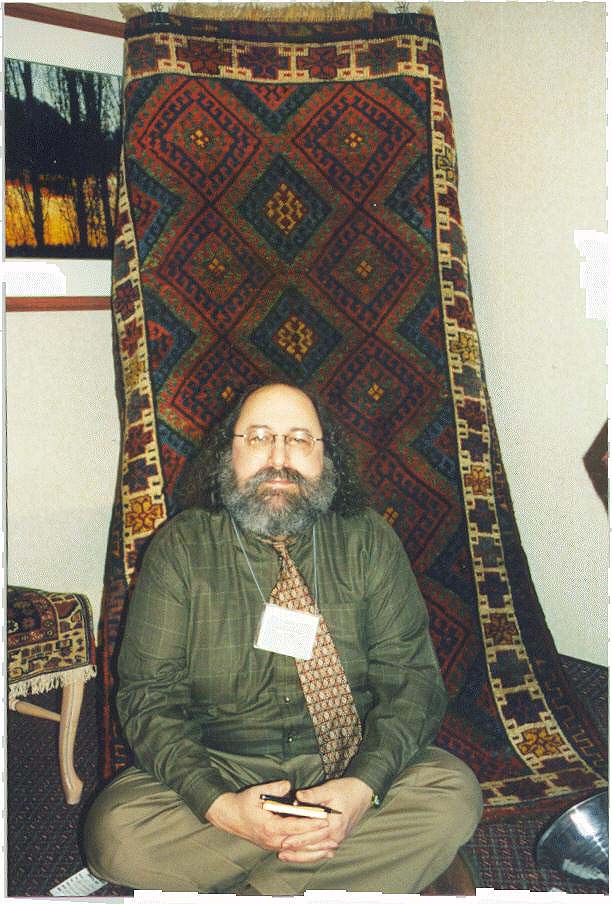
Damn, these ACORs are a good time!
Discussion















